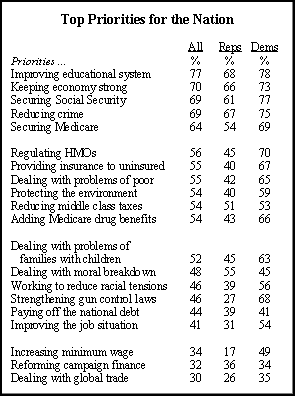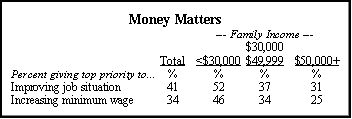’00 Priorities
 As President Clinton prepares to deliver his final State of the Union address Jan. 27, the public’s top priority — education — remains unchanged from recent years. But Americans are also sending a strong message to the president and the candidates who are vying to succeed him: Keep the economic boom going.
As President Clinton prepares to deliver his final State of the Union address Jan. 27, the public’s top priority — education — remains unchanged from recent years. But Americans are also sending a strong message to the president and the candidates who are vying to succeed him: Keep the economic boom going.
Seven-in-ten Americans (70%) say that keeping the economy strong should be a top priority, placing that behind only improving education (77%) on the list of national priorities. Rounding out this year’s top five are perennial concerns such as securing Social Security and Medicare and reducing crime.
While the public is keenly interested in maintaining the current wave of prosperity, its anxiety over the nation’s employment picture has markedly decreased. Just 41% say that improving the job situation should be a top priority, down from 54% in July 1999 and 66% just three years ago.
As the president and the Republican-led Congress get ready to square off for the final time, there is a substantial partisan divide over a number of key legislative issues. Nearly half of Democrats (49%) call raising the minimum wage a top priority, against just 17% of Republicans. The gap over whether to enact tougher gun control laws is even larger, with more than two-thirds (68%) of Democrats naming it as a top priority, versus 27% of Republicans. Democrats place a greater priority than Republicans on regulating HMOs, insuring the uninsured, and adding prescription drug benefits for Medicare recipients.
Significantly, Democrats even attach equal or higher priority to a pair of the GOP’s signature issues — taxes and crime. More Democrats than Republicans rate reducing crime a top priority (75%-67%); and as many rate cutting middle class taxes (53%-51%) a top priority. The only issue that Republicans rate more highly than Democrats is dealing with the country’s moral breakdown (55%-45%).
On many issues, particularly economic matters, the gap between rich and poor is as formidable as the partisan divide. Roughly half of Americans with family incomes of less than $30,000 a year rate improving the job situation and boosting the minimum wage as top priorities; but of those making at least $50,000, fewer than one-third (30%) attach as much importance to improving the job situation, and just 25% consider raising the minimum wage to be a top priority.
 Men and women also disagree, on issues ranging from gun control to health care. A strong majority of women (57%) consider tougher gun laws a top priority, while slightly more than one-third of men (34%) agree. More women than men attach greater priority to adding a prescription drug benefit to Medicare (61%-47%) and providing health insurance to the uninsured (62%-47%).
Men and women also disagree, on issues ranging from gun control to health care. A strong majority of women (57%) consider tougher gun laws a top priority, while slightly more than one-third of men (34%) agree. More women than men attach greater priority to adding a prescription drug benefit to Medicare (61%-47%) and providing health insurance to the uninsured (62%-47%).
Not surprisingly, there is a sizable generation gap on questions relating to Social Security and Medicare. More than three-quarters (78%) of those age 50 to 64 say securing Social Security should be a top priority; that is the highest-rated issue for this group. Nearly seven-in-ten (68%) of those age 30-49 rate Social Security a top priority; that group’s top priority is improving education (75%). Just 57% of those in the 18-29 age group consider Social Security a top priority. Improving education is the most important issue for these younger Americans, with 85% naming it a top priority.
Presidential Campaign Gains Attention
 Interest in the presidential election has risen slowly but steadily since last summer and is now higher than at a comparable period in past election cycles. Fully 19% are following news about this year’s presidential election very closely, up from 11% in June 1999, when the Pew Research Center began asking whether Americans were following the campaign. And the percentage following very closely is nine points higher than in January 1996 and eight points higher than in January 1992.
Interest in the presidential election has risen slowly but steadily since last summer and is now higher than at a comparable period in past election cycles. Fully 19% are following news about this year’s presidential election very closely, up from 11% in June 1999, when the Pew Research Center began asking whether Americans were following the campaign. And the percentage following very closely is nine points higher than in January 1996 and eight points higher than in January 1992.
Likely voters are even more tuned into the campaign. Of those who say they always vote, 29% are watching the campaign very closely.
In contrast, however, Independents are not as engaged by the presidential race. Almost the same percentage of Democrats and Republicans — 22% and 23%, respectively — are paying very close attention to the race; only 14% of Independents are doing so.
Reflecting increased interest, all of the candidates are now better known, although only the frontrunners are readily recalled. When asked to name GOP presidential candidates, George W. Bush is volunteered by 71% of Republicans, an 11 percentage point gain since September. In comparison, only about one-quarter (27%) of Republicans and those leaning Republican know John McCain is a presidential candidate. That represents a large increase from the 10% who mentioned him only a few months ago but still places McCain far behind Bush. Al Gore is mentioned by more than half (55%) of Democrats and those who lean Democratic, up from 47% last September. Although Bill Bradley’s recognition jumped 14 percentage points since fall, it still lags behind Gore.
Most Americans — 68% — can identify George W. Bush as governor of Texas but fewer can cite basic biographical information about Bill Bradley or John McCain. Only 30% are able to identify Bradley as a former U.S. senator from New Jersey, and significantly fewer (17%) correctly name McCain as the co-sponsor of a campaign finance reform bill. In fact, more Republicans correctly identify Bradley’s former elective office than Democrats. More than one-third (36%) of Republicans know that Bradley was a New Jersey senator compared to only 27% of Democrats.
 And in each of three questions regarding the candidates, older men are much better informed than either women or younger men. For example, 91% of men age 50 and older know that Bush is governor of Texas compared to only 69% of women in the same age group and 57% of men under age 30.
And in each of three questions regarding the candidates, older men are much better informed than either women or younger men. For example, 91% of men age 50 and older know that Bush is governor of Texas compared to only 69% of women in the same age group and 57% of men under age 30.
News Interest Index
Although attentiveness to the presidential campaign is increasing, the debate over whether 6-year-old Elian Gonzalez should return to Cuba tops the news interest index for the month, with almost four-in-ten Americans (39%) saying they have followed this story very closely. Nearly as many people — 35% — paid very close attention to coverage of millennium celebrations around the world.
In other domestic news, 23% paid very close attention to the arrests of suspected terrorists, and the merger between America Online and Time Warner was followed very closely by only 17% of Americans. Internationally, the release of hostages from a hijacked Indian Airline jet in Afghanistan garnered the very close attention of 19%. Two news stories about Russia — the resignation of Boris Yeltsin and the conflict in Chechnya — received the least attention of recent major news events. Only 11% and 10%, respectively, paid very close attention to these stories. The Chechnyan conflict received virtually the same level of attention as in prior years. The story was followed very closely by 11% in December 1999 and by 10% in 1995.
Older Americans and Democrats have followed the Gonzalez story very closely. Half of adults age 50 and older have kept a very close eye on this story while only about a quarter (27%) of adults under age 30 have done so. Similarly, nearly half (49%) of Democrats have paid very close attention to the 6-year-old’s saga compared to 35% of both Republicans and Independents.
Computer users tended to follow the story about America Online merging with Time Warner more closely than non-users, with one-in-five paying very close attention to it, compared to just 10% of those who do not use a computer. Almost a quarter (24%) of people with incomes of over $75,000 also followed the merger very closely; only 13% of Americans with incomes of $20,000 or less did so.
In both news stories about Russia, older Americans were more attentive than other age groups. Among those age 50 and older, 16% paid very close attention to the conflict in Chechnya compared to only 4% of those under age 30. And 16% of those age 50 and over tuned in very closely to Yeltsin’s resignation while 7% of younger adults did so.
Wobbly New Hampshire Polls
 Three New Hampshire polls of likely Democratic primary voters, all conducted in early January, had widely varying results. The Newsweek survey showed Gore ahead of Bradley by a healthy margin (50% to 36%), while the Washington Post/ABC News poll had the two men in a statistical dead heat (Bradley leading 48% to 47%). Bradley led Gore in the Quinnipiac survey (47% to 37%). Differing percentages of Independents in the three polls accounted for some of the variation — independent voters who plan to vote in the Democratic primary made up 45% of the Newsweek sample, 30% of Post/ABC sample, and 36% of those surveyed in the Quinnipiac poll. There has been less variability on the Republican side, where most recent polls show McCain with a modest lead.
Three New Hampshire polls of likely Democratic primary voters, all conducted in early January, had widely varying results. The Newsweek survey showed Gore ahead of Bradley by a healthy margin (50% to 36%), while the Washington Post/ABC News poll had the two men in a statistical dead heat (Bradley leading 48% to 47%). Bradley led Gore in the Quinnipiac survey (47% to 37%). Differing percentages of Independents in the three polls accounted for some of the variation — independent voters who plan to vote in the Democratic primary made up 45% of the Newsweek sample, 30% of Post/ABC sample, and 36% of those surveyed in the Quinnipiac poll. There has been less variability on the Republican side, where most recent polls show McCain with a modest lead.


